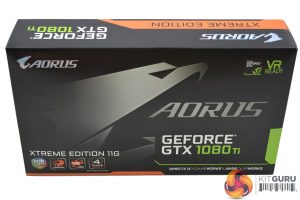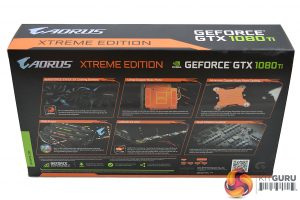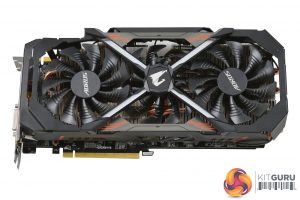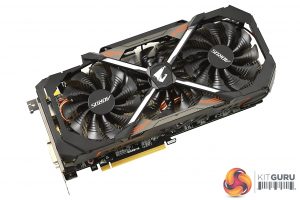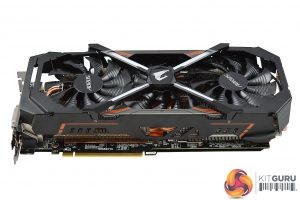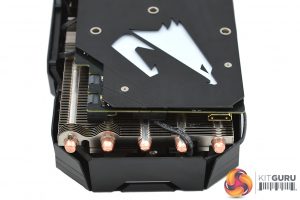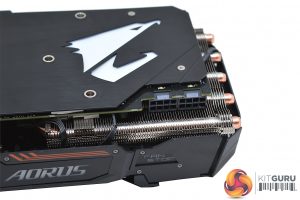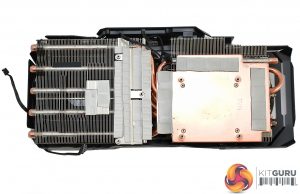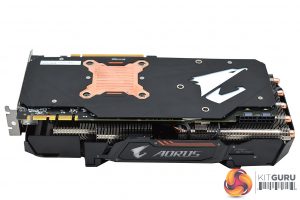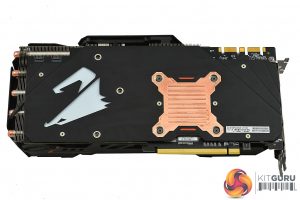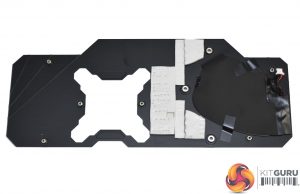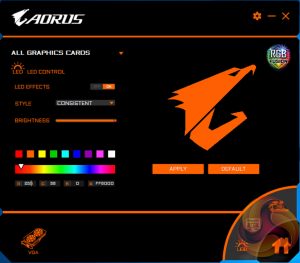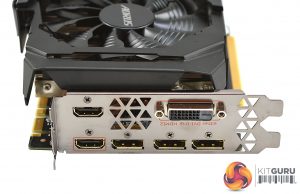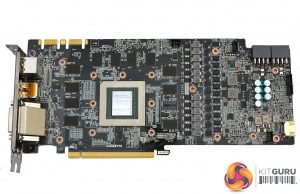The packaging for the Gigabyte Aorus GTX 1080 Ti Xtreme Edition is very clear in highlighting the USPs of this graphics card: it's triple fan design, full copper base plate and copper back plate, RGB lighting system, VR HDMI port and 12+2 phase power design.
The accessory bundle includes some documentation, a case badge and a power adapter. Prospective buyers will want to take note because an included registration card gives you an opportunity to extend your 3 year standard warranty to 4 years. It's not specified if this is time-limited but it would be prudent to register as soon as possible after purchasing.
The design is striking and unique, definitely not what we'd call subtle but certainly not offensive either. Gigabyte uses three 100mm fans which are covered by an X-Shape cross member that bares the Aorus logo. Incidentally, this is removable by four Philips-head screws if so desired.
The whole shroud, aside from the X-Shape add-on, is made from metal which adds a quality feel and rigidity to the product. The centre fan, as can be seen from the close up, differs from the two outer fans. The differentiation on the design is for functional reasons: so Gigabyte can fit all three fans in length-ways without the blades hitting each other during rotation.
Technically, the centre fan spins underneath both the left and right fans by a couple of centimetres on both sides, but the unique blade design means these fans never touch. However, we aren't sure what the impacts of overlapping fans are on the consequent airflow.
Gigabyte's cooling solution utilises six heat pipes to route heat away from the GPU core, 5 of those finish at the tail-end of while one finishes near the rear I/O. All the key PCB power components are cooled by the cooler as shown by the large number of thermal pads and the corresponding indentations within them.
The Aorus card draws power through two 8-pins PCIe connections supporting, in theory, up to 375 watts of total power delivery for the card. This power input is channelled through a 12 phase VCore VRM and 2 phase VRAM VRM.
The HDMI port that is visible from this end of the graphics card is specifically intended for use with VR headsets.
The rear of the card uses a full metal backplate as well as secondary copper backplate specifically to cool behind the GPU. The main backplate does have thermal pads to transfer heat away from the components on the rear of the PCB so this is both a functional and aesthetic design.
The LED regions on this graphics card are as follows:
- The Aorus logo on the rear I/O
- The white strips on the X-Shaped cross member
- The Aorus logo and text on the top of the graphics card
- The Fan Stop text on top of the graphics card which only illuminates when the fan has stopped.
All the LEDs are configurable through the AORUS software but they are all treated as a single LED zone meaning they cannot be configured independently of one another.
The rear I/O is unique as far as GTX 1080 Ti graphics cards go. Gigabyte has a total of 7 connections, 6 on the rear I/O and 1 VR Mode HDMI port at the opposing end of the graphics card.
The connectivity options for this graphics card can be confusing with lots of permutations possible though Aorus has simplified it into two scenarios:
- VR-Mode: 4 outputs can be used from any combination of the three Display Port connections and three HDMI connections. The DVI-D cannot be used in this scenario.
- Standard Mode: 4 outputs can be used from any of the remaining outputs left after excluding HDMI2 and the VR HDMI port.
Any use of the DVI-D port will disable the VR mode so it's an either/or scenario. Gigabyte provides an explanatory diagram with the documentation bundle so any buyers will not be left confused.
Gigabyte uses a 12+2 phase power design on the PCB capable of supplying considerably more power than the GPU will likely ever need under normal usage, even overclocked. In total it can easily deliver the maximum 375-watts of the available power connectors. Gigabyte is one of the only GPU vendors to allow a 150% power target that enables the functioning TDP of the card to be raised from 250W to 375W.
It's not entirely clear how the power circuitry regulation is configured though it has been suggested that Gigabyte is using “quadruplers” meaning 3 true phases are turned into 12 effective phases while something like the ASUS GTX 1080 Ti STRIX uses 5 true phases going through “doublers” to get a 10 phase solution for the VCore.
This Gigabyte solution is less elegant but still results in the same power output capability as it's main rivals, like the ASUS card. In short, it's a high quality power delivery solution but the ASUS equivalent is slightly better. Though in real world usage you're unlikely to ever notice a difference and overclocking limits will be limited by the silicon and not the power delivery system.
Be sure to check out our sponsors store EKWB here
 KitGuru KitGuru.net – Tech News | Hardware News | Hardware Reviews | IOS | Mobile | Gaming | Graphics Cards
KitGuru KitGuru.net – Tech News | Hardware News | Hardware Reviews | IOS | Mobile | Gaming | Graphics Cards


